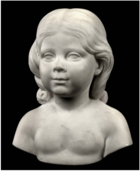Anne Whitney
She made full-length and bust sculptures of prominent political and historical figures, and her works are in major museums in the United States.
[1] From 1847 to 1849, she ran a small private school in Salem, Massachusetts, after which she traveled by ship to visit cousins in New Orleans, via Cuba, from December 1850 to May 1851.
Rather than following what was considered a more acceptable path for women of that era to explore her interest through poetry, she sought to fully express her viewpoints about social causes through art.
[6] She made Laura Brown (1859), a bust of a young girl, and exhibited it at the National Academy of Design in New York.
[5] She associated with a group of female artists in Rome that Henry James described as the "that strange sisterhood of American 'lady sculptors' who at one time settled upon the seven hills in a white, marmorean flock".
[13] While Whitney was in Italy there was political, social, and economic instability due to the attempts to unify the country, during which the new secular government was at odds with the papacy.
[12] She created the bronze sculpture Roma in 1869[5] to represent the "spiritual destitution" that the citizens experienced due to the political climate, symbolized by the ancient beggar woman.
[8] In 1875, she submitted a model sculpture of Charles Sumner for a blind competition conducted[2][14][15] by the Boston Art Committee.
New York Evening Telegram wrote a verse which starts out: "You see, ’tis a fixed law of art, my friend, / That only a man can superintend / The play of muscle and post of limb, / Whenever a statue is made of him."
The verse later states "Yet under the dome of the Capitol / Stands Samuel Adams erect and tall, / As free as his namesake before the fall; / And though the image was carved by woman / Rarely is marble so grandly human.
"[4] Among her well-known public monuments is the statue of Samuel Adams (1876) in the National Statuary Hall Collection in the US Capitol, Washington, D.C.[8][16] Whitney traveled to Italy in 1875 to acquire the marble for the sculpture.
[5] During the trip, she studied French sculpture techniques at Écouen, realized in her work Le Modèle, which was created with a degree of Realism.
[2][19] She depicted Alice Freeman Palmer, President of Wellesley College; economist Harriet Martineau; and suffragists Frances Willard and Whitney's cousin Lucy Stone,[2][3] which is in the Boston Public Library.
[24] She completed statues and busts of other famous individuals, such as Edward Charles Pickering and James Walker, presidents of Harvard University.
[27] A replica of this fountain was cast at the request of Mariana Porter, and is located in West Newton, MA on the corner of Chestnut and Highland Streets, installed in memory of Anne Whitney's close friend, Catherine Porter Lambert (1817–1900), who also came from a family of abolitionists.
[3] Throughout her adulthood, she was an advocate for forest conservation, women's rights, abolition of slavery, and equal educational opportunities for African-Americans.
[2] Whitney was an individualist, who lived independently and cut her hair short, which annoyed her Victorian neighbors.
[29] One of her friends and supporters was writer Annie Adams Fields, who found her to be a "noble, simple, strong living woman.
[11][12] They had what was called a "Boston marriage", a term for a long-term relationship between upper-class, educated women, which was generally accepted within the community.
"[26] Whitney died on January 23, 1915, in Boston, Massachusetts[8] of cancer and was buried in Cambridge at Mount Auburn Cemetery[2] alongside Abby Adeline Manning.
She created prominent monuments for public sites, like the United States Capitol, of historical figures Samuel Adams, Charles Sumner, and Leif Erikson.
[12] Her works, though, are in a number of museums and collections, including Davis Museum at Wellesley that has seven of her works, Roma, Harriet Martineau, Abby Adeline Manning, Ann Mary Hale, Alice Freeman Palmer, Relief of George H. Palmer, and Eben Norton Horsford.
[30] Whitney also modeled for Cyrus Dallin's 1915 sculpture of Anne Hutchinson that is on the grounds of the Massachusetts State House.



